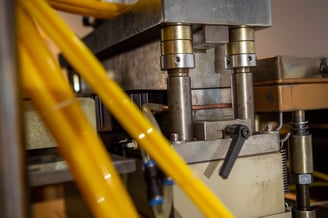What Is RPET?

In most modern industries, minimizing costs while maximizing profits and maintaining a consistent standard of quality is the key to a company’s survival. The best way to streamline your expenses is by evaluating the materials and equipment your company uses.
One of the most popular materials in recent times is a type of plastic called RPET. Many manufacturers including our team here at Ready-Made use it regularly, and have benefited greatly from doing so. What is RPET, though, and is it the right material choice for your business? Keep reading to find out.
What Is RPET Made Of?
First and foremost, what is RPET, and what is it made of? RPET (Recycled Polyethylene Terephthalate) is a plastic made from recycled scraps of PET plastic. This makes it a highly durable, affordable, and eco-friendly material.
While the words “plastic” and “eco-friendly” aren’t usually associated, PET can be recycled losslessly. This means that 100% of recycled PET scraps can be turned into RPET, with no excess or wasted materials. In addition, high-quality RPET products have an extremely long lifespan, and can withstand years or even decades of regular use.
What Industries Use RPET Plastic?
If you’re considering using RPET material for your business needs, it helps to know how it has been used in various industries. Because it’s such a versatile material, it has equally versatile applications, so your business can most likely find a use for it.
Automotive & Aerospace
The automotive and aerospace industries often require delicate machine parts to be shipped over long distances. Throughout the shipping process, packages will be disturbed, hit bumps in the road, or go through patches of turbulence. This combination of continuous and sudden shocks can damage machine parts, causing them to be dead on arrival. RPET materials like packing trays from Ready-Made can help protect these components from harm, ensuring they arrive at their destination in perfect condition.
Medical & Lab Settings
Medical and lab settings require sterile trays for tools, components, and other important items to be placed for easy access. Thermoformed RPET trays are an excellent choice for this use case. The material is designed to work under far more strenuous conditions, so it’ll last for years to come in this setting, it keeps important items organized, and it’s easy to clean after a procedure.
RPET Material vs. Other Materials
This raises an important question, though: why pick RPET over other materials? With so many options on the market, you want to ensure that your business is getting nothing but the best. When looking for great materials, we generally consider a few factors like effectiveness, price, durability, and environmental sustainability. You may be surprised to learn just how many ways RPET sets itself apart from the crowd.
Other Plastics
While other plastics are similar in terms of cost efficiency, effectiveness, and durability, RPET is simply better for the environment. Many plastic products are designed to be single-use, and not all plastics can be recycled. This leads to a huge amount of industrial plastic waste every year, which makes it difficult to justify using if your company is trying to run an eco-friendly operation.
Compare that to RPET, which is recycled to begin with, and can be recycled infinitely. Assuming all else is equal, RPET emerges as the victor because of its reduced environmental impact. RPET is a common material choice for the medical, automotive, aerospace and food industries.
Metal
While metal is similar to RPET plastic in the sense that it’s durable and easy to recycle, it comes with a few key drawbacks. First, is the weight. Most industrial metals are far heavier than RPET, which leads to greater energy and shipping costs.
Cost is also an important consideration. Metal products are much more expensive to produce and customize when compared to RPET products, so they may be too heavy of an investment for your business. Between these two factors, RPET plastics emerge as a clear winner.
Paper & Cardboard
Paper and cardboard are both effective solutions for shipping and short-term storage, but they have one major shortcoming: poor durability. Paper and cardboard materials degrade quickly, and will degrade even faster if exposed to moisture or humid conditions. If this happens, it places the products or components being stored at risk of damage and forces you to buy new cardboard storage containers.
RPET, needless to say, has no such shortcoming. RPET products like those from Ready-Made are designed to work exactly as intended under any circumstances you could reasonably put them through. They won’t bend or tear under pressure, they won’t rot or degrade when exposed to moisture, and they won’t regularly need to be replaced. Once again, RPET is the clear winner.
Styrofoam
The comparison between styrofoam and RPET materials once again comes down to a question of sustainability. Both are very cheap to purchase, and styrofoam is fairly durable, albeit less so than RPET. Styrofoam, however, can’t efficiently be recycled, so it usually ends up in a landfill. It can degrade in these landfills, and when it does, it will leach toxic chemicals into the ground, and thus into the watershed.
Simply put, it’s a non-option for environmentally-conscious companies. RPET does all the same great things as styrofoam, but does them better and without the heavy environmental impact, so it’s an excellent choice here.
Learn More About What RPET Is
Now that you know what RPET is, you may be interested in some of its more specialized applications. Our team here at Ready-Made can help match you with the perfect product for your use case, or even help you design an entirely new product. If you’re interested in working with us or want to place an order, feel free to contact us today!
Sources:
https://napcor.com/frequently-asked-questions/
https://archive.epa.gov/water/archive/web/pdf/archived-consumer-fact-sheet-on-styrene.pdf



